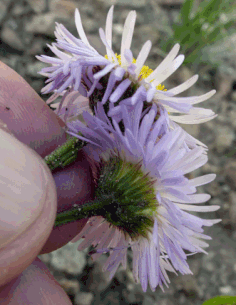New Mexico Wildflowers: Aster Family by Genus, A-B
(Asteraceae)

Most flowers of the aster family usually have a central nubbly flower disk (which can be inconspicuous) surrounded by "petals" (rays). Sunflowers are a classic example. If you look carefully at the thumbnail to the left (of a golden crownbeard), you'll see a few of the tiny actual flowers, which are five-pointed (the nubbles farther in are flower buds). A larger picture, immediately below, also shows the ray-disk structure.
Don't be surprised by exceptions. For example, flowers on fragrant snakeroot, shown below, lack rays.
The aster family includes so many species in New Mexico that I had to split this page into four. Genera beginning with A or B are on this page. Click on the links to see genera beginning with C through F, G through M, and N through Z.


The Aster family includes both daisies and asters. So how do you tell them apart? As I learned eventually, you need to look at the phyllaries—also known as bracts—the things that make up the green cup that a flower sits in. In daisies, such as the one to the left, the phyllaries are long and parallel, like vertical boards in a board fence. In asters, the phyllaries are shorter and arranged like shingles on a roof.
That's the claim, anyway. Sometimes I find things called daisies that have what look like aster phyllaries to me. Or vice versa. Sometimes I check the phyllaries and can't tell which pattern I'm looking at. Both daisies and asters are part of the aster family, so perhaps it doesn't matter. But if like me you're trying to learn your wildflowers, take a picture of the phyllaries to help you nail the ID.
When you encounter a slide show, hover your cursor over the images to control the images. Those are in alphabetical order by genus and species.
Western Yarrow (Achillea millefolium)
Look for the feathery leaves as well as for the thick clusters of tiny white flowers.
Fragrant Snakeroot (Ageratina herbacea)
Burnt-Orange Dandelion (Agerosis aurantiaca)
Like a common dandelion, this species has a puffy seed head.
Rag-Leaf Bahia (Amauriopsis dissecta)
My only photos so far are from late in the growing season. Look for a cluster of basal leave that are deeply notched, with simpler-looking leaves (often three-part, even one-part) higher on the stems.
Perennial Ragweed (Ambrosia psilostachya)
Pussytoes (Antennaria spp.)
These flowers occur on stalks that extend well above the basal leaves.
Leafy or Chamisso Arnica (Arnica chamissonis)
On one of my photos you'll see a butterfly. If you go to one of my butterfly pages, you'll see other images of those butterflies feasting on the nectar of Chamisso Arnica blossoms.
There's no relationship between the "Chamisso" in the name of these flowers and the chamisas featured elsewhere on this page. The flowers shown above are named after Adelbert von Chamisso, a botanist. Your useless fact of the day!
Dragon Wormwood, Wild Tarragon (Artemisia dracunculus)
My ID to the species level is based on Littlefield and Burns but be warned, at least one other species of Artemisia looks similar. To see a photo of Wooly Bud Gall Midge galls on this plant, visit this page.
Sand Sage (Artemisia filifolia)
Fringed Sage (Artemisia frigida)
The soft, silvery-green branches of this species, with their clusters of leaves, give this species the popular name I'm using here. When the flowers are at their peak (which they aren't in my photo), the disks are yellow.
Common or Lesser Burdock (Arctium minus)
I was a bit surprised to find burdock growing near the Rio Grande in Albuquerque. The plants I saw were too young to have flowers, which look like purple thistles.
Mule Fat, Seepwillow (Baccharis salicifolia)
This is a shrub, so on mature plants look for woody lower branches to go with the narrow pointed leaves and the crowns of small white flowers. I'm labeling these plants Baccharis silicifolia because of the many small, evenly spaced teeth on the leaves. The similar B. salicina (below) has fewer, larger teeth on its leaves. Be warned that despite my ID, according to at least one source B. salicina ranges into the Albuquerque area and B. silicifolia supposedly does not.
Emory's Baccharis (Baccharis salicina)
On Emory's baccharis the teeth on the leaves are fewer and larger than on mule fat. Also, the leaves are less willow-like.
Desert Marigold (Baileya Multiradiata)
The leaves are helpful for distinguishing this yellow flower from other species (see the next flower), so one of the pictures is a close-up of the leaves.
Woolly Desert Marigold (Baileya pleniradiata)
A neighbor of mine lets these grow in her yard. They're so similar to the Desert Marigolds in the previous photo series that I'm not entirely convinced of my ID. One reason to classify them separately is the many small, narrow, pointed leaves climbing the flower stalks.
Chocolate Flower (Berlandiera lyrata)
This flower is supposed to smell like chocolate, especially first thing in the morning or late at night. It's become a popular choice for xeriscaping, and my May 2020 photos show either cultivated or escaped examples. In contrast, my July photos are from open desert, where both the petals and the leaves are skinnier. Less water, less plant.
Nodding Burr-Marigold (Bidens cernua)
If you're ever tempted to confuse Bidens with Heliomeris, note how non-hairy the bracts are on this species, and how the leaves have obvious small teeth along the edges.
Devil's Beggar-ticks, Devil's Pitchfork (Bidens Frondosa)
My amateur's impression of this species is that it has flowers with yellow centers and green leaves for petals. To be less inaccurate, the yellow flowers are surrounded by long green bracts.
California Brickellbush (Brickellia californica)
False Boneset (Brickellia eupatorioides)
Look for an unassuming small shrub with narrow leaves. In the late summer to early fall, False Boneset can be covered with flowers, albeit not very showy ones.
Tassel Flower (Brickellia grandiflora)
For the next page of aster family wildflowers, click here.























































































































































